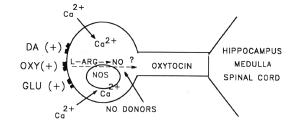- Abstract :
- 1. Recent experimental evidence has shown
that nitric oxide (NO) plays an important role
in the expression of penile erection and yawning
and that this molecule has to be added to the
list of the best known neurotransmitters and
neuropeptides involved in this
symptomatology.
-
- 2. This was first suggested by the ability
of NO synthase inhibitors injected in the
lateral ventricles (i.c.v.) or in the
paraventricular nucleus of the hypothalamus
(PVN) to prevent these behavioral responses
induced by dopamine agonists, oxytocin and NMDA.
The inhibitory effect of NO synthase inhibitors
was not observed when these compounds were
injected concomitantly with L-arginine, the
precursor of NO. Most important, this
hypothalamic nucleus is one of the richest brain
areas of NO synthase and also the brain site
where dopamine, NMDA and oxytocin act to induce
penile erection and yawning by activating
central NO synthase containing oxytocinergic
neurons.
-
- 3. NO synthase inhibitors given i.c.v. but
not in the PVN prevent also penile erection and
yawning induced by ACTH and serotonin1c
agonists, which induce these responses by acting
with mechanisms unrelated to oxytocinergic
transmission.
-
- 4. Dopamine agonists, NMDA and oxytocin
increase NO production in the PVN at doses that
induce penile erection and yawning, as
determined by measuring the concentration of
NO2- and NO3- in the dialyzate obtained with a
vertical probe implanted in the PVN by in vivo
microdialysis.
-
- 5. NO donors, such as nitroglycerin, sodium
nitroprusside and hydroxylamine, induce penile
erection and yawning indistinguishable from
those induced by oxytocin, dopamine agonists or
NMDA when injected in the PVN. The NO donor
response was prevented by the i.c.v. injection
of the oxytocin receptor antagonist
d(CH2)5-Tyr(Me)-Orn8-vasotocin, indicating that
these compounds also induce penile erection and
yawning by activating oxytocinergic
transmission.
-
- 6. Finally, guanylate cyclase inhibitors
(i.e. methylene blue and LY 83583) and
hemoglobin injected in the PVN do not prevent
rug-induced penile erection and yawning, nor
8-Br-cGMP injected in the PVN induces these
behavioral responses suggesting that the
mechanism by means of which endogenous or NO
donor-derived NO facilitates oxytocinergic
transmission to induce penile erection and
yawning is not related to the activation of
guanylate cyclase. Furthermore, since
hemoglobin, in spite of its ability to prevent
drug-induced NO production in the PVN, does not
prevent penile erection and yawning, it is
likely that NO acts as an intracellular rather
than an intercellular modulator in the PVN
neurons in which is formed to facilitate the
expression of these behavioral responses.
-
 - A hypothetical mèchanism of action by
means of which oxytocin, dopamine and glutamic
acid (through NMDA receptors) facilitates the
expression of penile erection and yawning by
stimulating NO synthase in the PVN. According to
this model, a group of oxytocinergic neurons
projects from the PVN to extrahypothalamic brain
areas (i.e. the hippocampus and/or the ventral
medulla/spinal cord).
- Oxytocin, dopamine and glutamic acid induce
penile erection and yawning by activating these
neurons the first two through the stimulation of
specific receptors coupled to
ornega-conotoxinsensitive Ca2+channels by a
pertussis toxin-sensitive Go protein and the
third one through the stimulation of
Ca2+channel-coupled NMDA receptors. This would
cause an influx of Ca2+ions that would activate
NO-synthase. NO formed endogenously (or derived
by NO donors) in turn activates yet undiscovered
processes which activate oxytocinergic neurons,
that induce penile erection and yawning by
releasing oxytocin in areas distant from the
PVN. When activated, for instance by oxytocin or
dopamine, these neurons can be inhibited by
opioids by a still unknown mechaninsm.
-
Yawning :
role of hypothalamic paraventricular nitric
oxide
- Melis, M. R. and A.
Argiolas
- Zhongguo Yao Li Xue
Bao 1999; 20; 9; 778-88
-
- Yawning is a phylogenetically old,
stereotyped event that occurs alone or
associated with stretching and/or penile
erection in humans, in animals from reptiles to
birds and mammals, under different conditions.
Several neurotransmitters and neuropeptides are
involved in its control at the central level.
One of these at the level of the paraventricular
hypothalamic nucleus (PVHN) is nitric oxide
(NO). First, NO synthase inhibitors injected
into this hypothalamic nucleus prevent yawning
induced by dopamine agonists, oxytocin or
N-methyl-D-aspartic acid (NMDA), which induce
yawning by activating PVHN oxytocinergic neurons
projecting to extra-hypothalamic brain
areas.
-
- The inhibitory effect of NO synthase
inhibitors was not observed when these compounds
were given concomitantly with L-arginine, the
precursor of NO. Second, dopamine agonists, NMDA
and oxytocin given at doses that induce yawning,
increase NO production in the PVHN, as
determined by in vivo microdialysis. Conversely,
the opiate morphine, which prevents yawning
induced by dopamine agonists, oxytocin and NMDA,
also prevents the increase in the
paraventricular NO production induced by these
compounds.
-
- Third, NO donors, such as nitroglycerin,
sodium nitroprusside and hydroxylamine, induce
yawning when injected into the PVHN apparently
by activating oxytocinergic transmission. Since
guanylate cyclase inhibitors and NO scavengers
(hemoglobin) injected into the PVHN do not
prevent drug-induced yawning, nor 8-Br-cGMP
injected into the PVHN induces this behavioral
response, it is likely that NO acts as an
intracellular rather than an intercellular
modulator inside the PVHN oxytocinergic neurons
in which NO is formed to facilitate the
expression of this phylogenetically old event by
guanylate cyclase-independent mechanisms.
-
|



